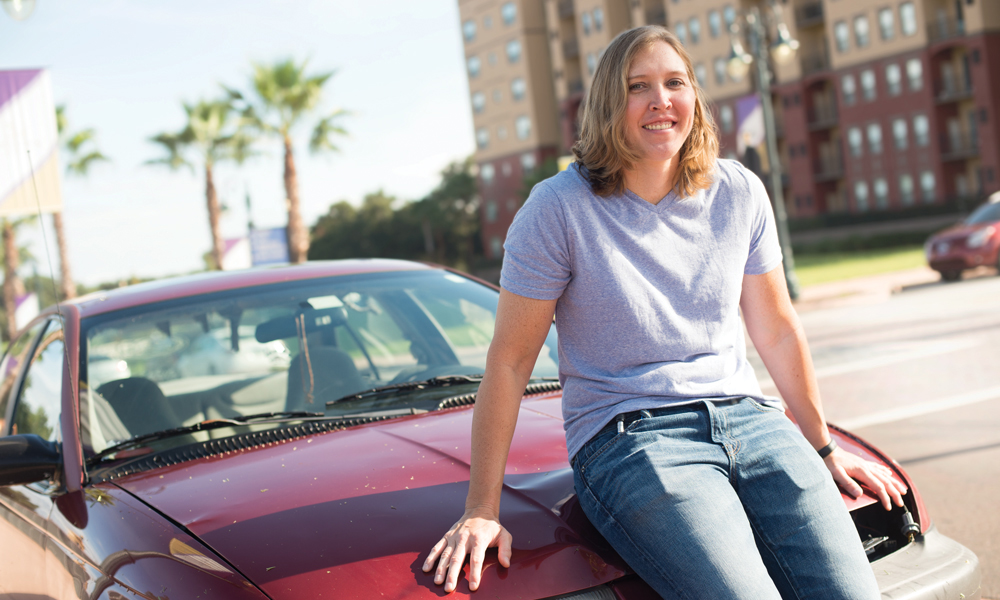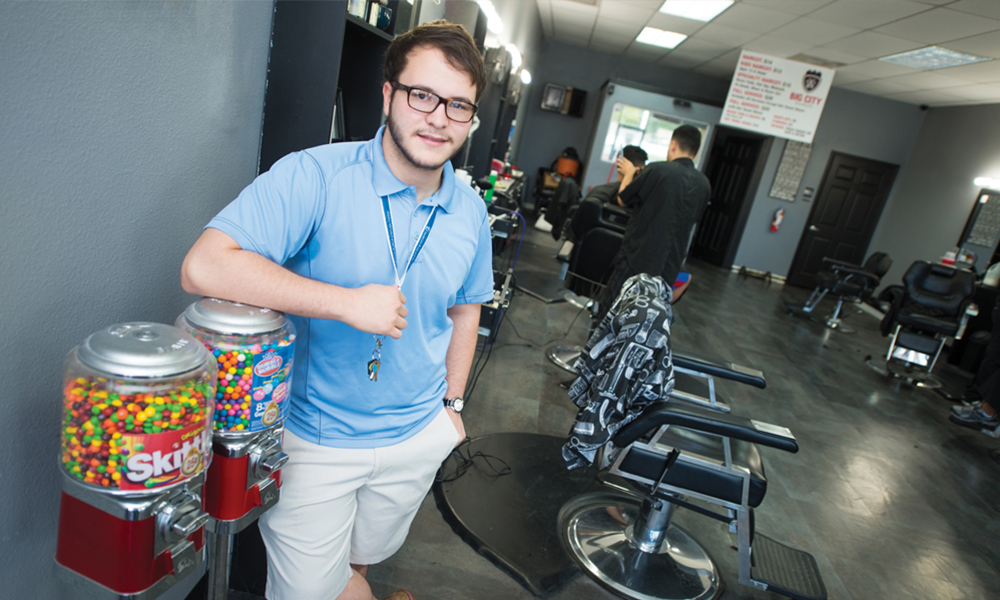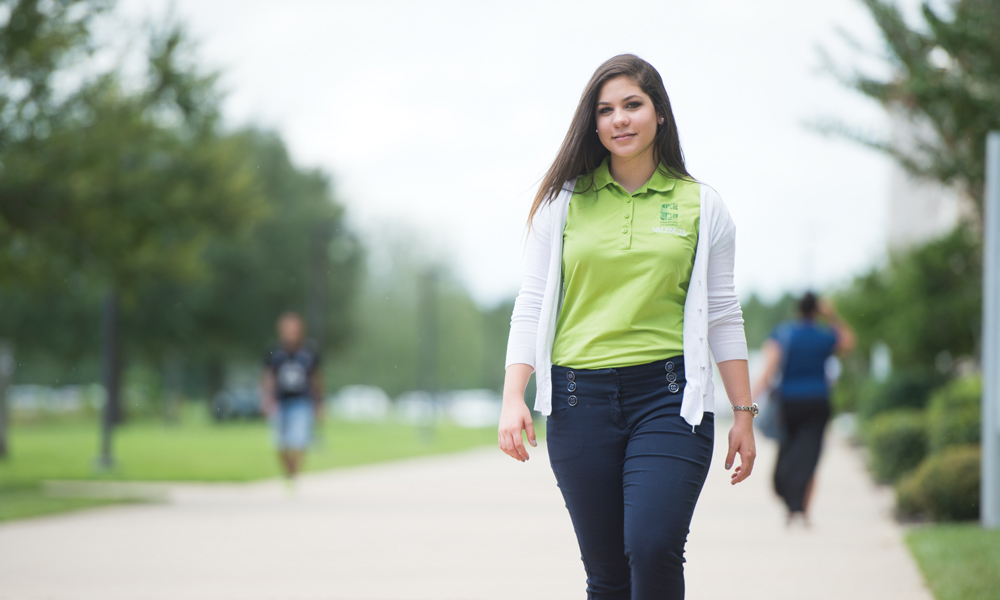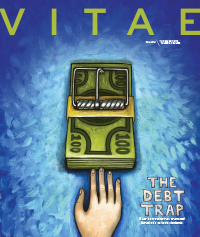BY LINDA SHRIEVES BEATY // Illustrations by Brian Demeter
It’s easy money. Sign on the dotted line and get a student loan. But the real pain comes later, as students grapple to pay back loans. At Valencia, students and college officials are working to stem the rising tide of student-loan debt.

my Austin lives like a typical college student. Small, bare-bones apartment. Drives a 15-year-old car with dents and a broken headlight. Eats pizza and ramen and lives close to the bone.
The only difference is: Austin graduated from college 13 years ago.
But she graduated with more than $60,000 in student loans. The loans weren’t just for tuition. Instead, Austin, who grew up in Illinois, moved to Florida to study at a for-profit college. So she had living expenses. Because her class schedule changed every month, she couldn’t hold down a part-time job. So she did what many of her fellow students did—borrowed money to pay for rent and food.
By the time she graduated, Austin had racked up tens of thousands of dollars in student loans. And to compound matters, after graduating with a degree in digital media, she couldn’t find a job in the field. “I ended up working at movie theaters, at Target and Home Depot,” she says.
As she scrambled to juggle minimum-wage jobs—and search for internships or entry-level jobs in her field—she had to face tough choices: Either pay back her loans or eat. Pay the loans or pay the electricity bill. For two years, Austin had to defer (or delay) paying her student loans—meaning that the interest just kept piling up. “When you’re in deferment, the interest really adds up,” she says. “Even if it’s a low interest rate, with that amount of money, it consumes you.”
Although she was frustrated and discouraged, Austin stayed focused on two goals: Paying down her student loans and trying to get a good job in her field. Through hustle and networking, she eventually began to land freelance jobs, including work as a contractor at video-game giant EA (Electronic Arts), working on games such as Madden NFL 25, Madden NFL 13, Tiger Woods PGA Tour 10, NCAA Football 10, EA Golf Challenge on Facebook and MLB Superstars on Facebook.

Amy Austin
Instead of racking up more student loans, she has enrolled at Valencia to earn an Associate in Science degree in film technology.
Now she has a contract job designing websites for a federal agency.
“It’s a double-edged sword,” Austin says. “Without that school, I wouldn’t have the knowledge base that I have.” But, she adds, many of those classes are available online elsewhere, for much less money.
And though she’s finally making a good, middle-class income, she still lives in a no-frills apartment in Altamonte Springs and drives her beat-up, red Saturn. “I am paying those loans off,” Austin says. “It feels good to say I’m down to $15,000. That’s why I live in a cheap apartment. I’m trying to pay off more than the bare minimum on the loan.”
Today, Austin is back in college. But this time around, she has taken a decidedly different approach. Instead of racking up student loans, she has enrolled at Valencia to earn an Associate in Science degree in film technology through Ralph Clemente’s program. Film is her passion—but she’s not going to go into debt to finance a film degree.
“A lot of film schools are $40,000-plus,” says Austin. “I can get out of Valencia for $5,000. And I’m not going to take out any student loans.”
After graduating from Valencia, Austin hopes to move to Vancouver and find work in the thriving TV and film industry there.
If she has any regrets, she says, it’s that no one warned her of the consequences of the student loans. “All of these are life lessons you wish someone would have told you along the way,” says Austin.
Loan Debt Rising
Americans now owe an accumulated $1.2 trillion in student loan debt, with student loans now the second biggest source of personal debt in the nation, behind only mortgage debt. Of the graduating class of 2012, 71 percent of college seniors had student loan debt—and the average student loan debt was $29,400.
What does that mean for the borrowers? Studies find that student-loan borrowers are less likely to save for retirement, take out home and auto loans or start a business.
Amy Austin knows that all too well. Were it not for her student loans, she might be driving a new car, she says, or taking vacations to Europe.
The lessons that Austin learned are not lost on Andy Torres.
Growing up in upper-middle-class neighborhoods of Celebration, Torres didn’t want for much. But when the housing bubble burst in 2007, Torres’ mother and stepfather found themselves living in a home that was worth a fraction of what they paid for it. And like many other people, they got caught up in a lifestyle of easy credit—new cars, vacations paid for with credit cards.
When the bubble burst, they filed for bankruptcy, downsized and moved to a small house in St. Cloud. Torres was 12 at the time.
“Looking back, that inspired me to make sure I’m not in that situation when I’m their age,” says Torres, now 18. Determined to avoid taking out student loans early in his college career, Andy chose to live at home for his first two years and attend Valencia, even though his good grades would have enabled him to go to four-year universities in Florida and out of state.
Studies find that student-loan borrowers are less likely to save for retirement, take out home and auto loans or start a business.

Andy Torres
And, because he was admitted to Valencia’s Bridges to Success program, his tuition is free. That will enable him to save his other scholarship money and apply it to his final two years of undergraduate study—when he hopes to attend Vanderbilt University and become an aerospace engineer.
In the meantime, he’s working part-time at Valencia and has a small business on the side.
“I have gumball machines in some local businesses in St. Cloud,” says Torres. “I reinvest the profits in the business and in the stock market. So far, I have more than $1,000 in the stock market right now.”
Eager to learn about finances, Torres signed up to become a Financial Ambassador at the Osceola Campus. And, after going through 33 training modules online, he helps teach other students how to save money and invest the money they earn. He has also discovered that many of his fellow students don’t know much about student loans or the impact that debt can have on your life after college.
“Hopefully, I’ll be lucky with my investments and leave college debt-free,” says Torres. “That’s my goal.”

Teaching Students About Debt
At Valencia, financial aid officials are trying to educate students about loans before students sign up for them. Although students used to be counseled about financial aid and student loans during orientation, now the college has included a more lengthy discussion of loans and debt in the New Student Experience class, a class that most incoming freshmen must take.
In addition, every student who signs up for a loan is required to participate in online financial counseling.
The college’s default rate—the percentage of Valencia students who are delinquent in paying back their student loans—was 17.5 percent in 2010. Although the college has been praised for its low default rate by The New York Times editorial board and others, college officials believe that the default rate should be lower.
That’s why, when Valencia students withdraw from classes and drop out, they get a call from the college’s financial-aid director, Christen Christensen, who informs them that they have to start paying back loans if they’re no longer in school. “What I find is that about half of them have left school because of a crisis,” says Christensen. So he urges students to find out which agency or company is handling their loan, and he lays out their repayment options.
In addition, another financial-aid staffer gets the names of former students who are in the early stages of loan delinquency from the loan processors and sends the former students an email. “It makes a difference,” says Christensen. “These students have a relationship with us. They don’t have a relationship with Sallie Mae or Nelnet or Great Lakes Higher Ed.” The staffer tells them about repayment options, including the option to defer payment or to try income-based repayment, which ties a student’s loan payments to his or her income. Although it may take longer to repay the loan, Christensen says, it may be worth it to avoid delinquency—and the hassles that a defaulted loan will wreak on one’s credit score.
But the best advice that Christensen can give students is in the early stages: Don’t take out loans to subsidize your new car, a new iPhone or a great apartment. “What students don’t understand is they can’t live the lifestyle they had with their parents,” he says. Instead, he urges them to sacrifice for a few years and live frugally because there are limits to how much students can borrow.
“My advice to students is to use as few loans as possible because if you’re going to transfer, you’ll need that money somewhere else,” says Christensen.
Statistics about loans and debt don’t mean much to an 18-year-old. So Ilia Cordero, financial aid coordinator at the college’s Osceola Campus, shares her experiences to demonstrate to students that no one is immune. In 2004, her family experienced its own financial crisis when her husband lost his human-resources job. With only one income, they had to sell their house as a short-sale and move in with Cordero’s mother. “It’s humbling to move back into your mother’s house at age 37, with your husband and your kids,” says Cordero. But that experience motivated her to teach students as much as she could about finances.
“For a lot of students, talking about money is taboo. But when we’re all talking about money, it’s no longer taboo,” she says.
And that’s the idea behind the Financial Ambassadors, teams of students who learn about banking, debt, student loans and how to live frugally—and then teach their fellow students with fun activities.
“To the students, anything financial is boring,” Cordero said. “We knew when we created this program that it had to be fun.”
Funded by a three-year grant from USA Funds, the program trains student leaders on financial matters—and then pays them each a small stipend to teach their fellow students, through events like the Haunted House, workshops and another popular annual event, the $50 Fashion Show, in which an entire outfit, from head to toe, is purchased for $50 or less (often from thrift stores or second-hand shops.)
For students, the message is simple: Don’t blow financial aid money and be wary of taking out too many loans. “We advocate trying to work part-time,” says Cordero. “It’s not that you can’t borrow, but why don’t you work part-time?”

Irene Acevedo
I wish someone had warned me that I should have saved that money, instead of spending it.
For Irene Acevedo, that message hits home. In her first year at Valencia, she received about $9,000 in grants because her father had been unemployed much of the previous year. Figuring that she’d receive the same amount of financial aid the next year, Irene spent her unused tuition money on extras—from eating restaurant meals to buying clothes. But this year, because her father is working, she received far less in financial aid—and realized she should have been more careful with the money.
“I wish someone had warned me that I should have saved that money, instead of spending it,” Acevedo says. “Now, when I hear other students’ stories, I tell them mine—so they won’t make the same mistakes that I did.”
What students need, they say, is a class in high school that lays out the options—and the consequences. “I don’t remember having that conversation in high-school economics class,” Austin says. “They teach you supply and demand but they don’t teach you the basics of everyday life.”
And Austin believes parents, who often have to co-sign loans, should be required to take classes on the subject too.
“I think high schools should require a summer session for students and parents to learn about student loans. It should be mandatory. By the time you get to college, it’s too late. Students go to private colleges with these loan packages and they’re stuck; they’re on the hook for the loans,” she says.
Financing a college education
//BY CHRISTEN CHRISTENSEN
What options do Valencia students use to pay for college?
Many Valencia students rely on Pell grants, which are given to needy students, based on family income. They do not have to be repaid.
If students don’t qualify for Pell grants, they may be eligible for federal student loans. Federal student loans offer two benefits over private loans: Interest rates on federal loans are low and students do not start repaying the loans until they have stopped going to college.
Does Florida offer 529 savings plans and prepaid tuition plans?
Florida offers families several college savings options, including prepaid plans that cover four years at a state university or a 2+2 plan that pays for two years at a state college and two years at a state university. For parents who want more flexibility, there’s also a 529 savings plan, which enables them to invest money in a tax-free savings plan.
If a student doesn’t make straight-As, are there scholarships available?
There are millions of scholarship dollars going unclaimed. Often, students do not want to expend the effort to apply—by writing an essay or filling out an application.
I encourage students to search for scholarships on websites such as fastweb.com, which matches a student’s characteristics with scholarships that he or she may qualify for.
In addition, check with your high-school guidance counselor—and even your local chamber of commerce—for information about community scholarships. Most colleges and universities have a scholarship page. At Valencia, we direct students to look at scholarships that Valencia offers.

